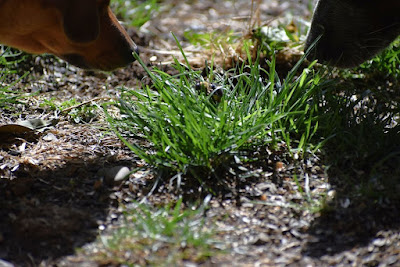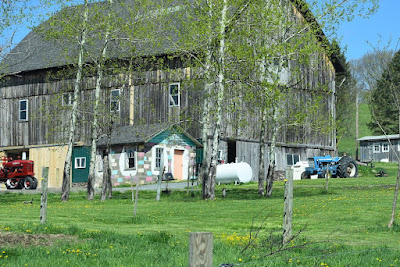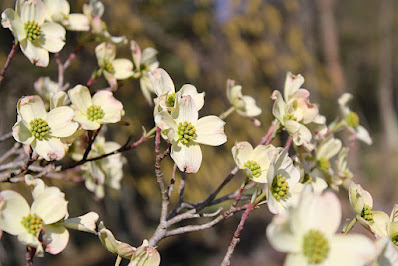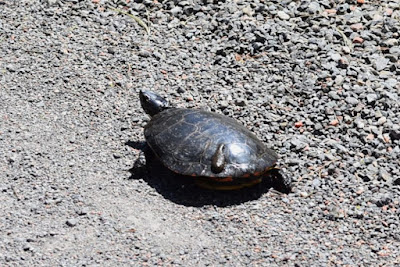Mike
was out mowing.
I was doing....
I don’t know.
Something else.
My phone rang. I
looked at the caller ID and saw it was Mike. He’s stuck, I thought. It’ll
be the first time this season.
“Grab your camera
and come down here,” he said.
“Down where?” I
asked.
“To the pond.”
I didn’t know if
I needed my regular camera or my zoom lens camera. I took them both.
Mike was still
mowing but shut the mower off when I got close.
“What is it?” I
asked.
“I think there’s a
dead woodchuck at the pond,” Mike said. “I went past him twice and he didn’t move.”
Mike pointed to
where I should look. As I walked up, I immediately noticed the soft chocolate-brown
fur of a beaver. “It’s a beaver!” I exclaimed.
There were flies
on a bald spot on his rump and landing elsewhere on him. “I think it’s dead.”
Then he woke up.
He rolled onto his feet and slipped into the pond.
Even though the mower didn’t bother him and even though our presence doesn’t seem to overly alarm him, I’m trying not to bother him too much.
“Let’s go see if
he’s still there,” I said late the next afternoon.
We got on the
golf cart and drove down around the pond. At first, we didn’t see him anywhere,
then, as we got to the other side of the pond he came swimming out of the
weeds.
We sat and watched as he swam to the side of the pond, climbed up on the bank, and just sat there.
“What’s he doing?”
Mike asked.
“I don’t know.”
I wonder if there’s anything I can do to help him, I wondered. Momma’s gone now, so I can’t ask her. But you know what? I have an older and much-adored sister who’s almost as smart and knowledgeable as Momma was. I called Patti.
“I think I have
an injured beaver at my pond. What can I do to help him?”
Patti thought
about it for a moment. “Hmmm. I don’t think there’s anything you can do. He’ll
probably be gone in a day or two.”
The next day when
we went to check on him, he was sitting nose-in to the bank. I thought he was
going to dig a burrow.
The next day we didn’t
see him. “Maybe he’s in his burrow. Let’s go around the pond one more time.”
Then I spotted him up on the bank. The weeds are filling out and he blends in
so well, he’s hard to see.
Yesterday, Mike
was mowing and called me. “Get your camera and come out here.”
I grabbed my
camera and went out front. I suspected Mike was calling me about the beaver. I
looked toward the pond and saw the beaver up by the tree. I was puzzled as to
why Mike was calling me about that.
Mike came across the yard in the golf cart to pick me up.
“What?” I asked as
I climbed onboard.
“He’s sitting under the little bridge and it’ll be a cool picture.”
“He was just up by the tree when
I came out.”
We get down to
the pond and he’s gone. Floating in the water are beaver-cut tree branches. I
think he’s cutting the suckers from around the bottom of the tree. And that
would explain why he goes under the little bridge. It’s his branch-eating
place.
We didn’t see him in
the water but as we get around the other side I see his den. It’s a lot lower
on the bank than where I’d thought he was digging. It’s really close to the
water line. The water in that area was muddy where he’d been kicking the
excavated dirt. I wonder if he’ll get flooded when the next rain comes and our
pond fills up.
I zoomed in as
much as I could and took a picture of the den. On the computer screen I can see
his slick fur. It’s not a deep burrow or he didn’t feel the need to go in very
far.
“At least there’s lots of frogs for him to eat,” I said.
Don’t laugh. I didn’t
know they were strictly vegetarians. I just made a bad assumption. I asked
Copilot, my AI buddy, what beavers eat.
“Their diet
consists mainly of tree bark, leaves, aquatic plants, and roots. They rely on
woody vegetation and soft plants for nutrition rather than hunting or consuming
meat.”
So! Our pond has a lot
of spadderdock and cattails in it and I don’t care if he eats them all! But I
think he likes the leaves of the tree next to the pond and that’s why he’s cutting
and eating the sucker trees. Maybe this week I’ll try to toss some willow
branches down under the little bridge so he doesn’t chew on the big tree. And
if he is hurt, having food close by will cut down on his foraging time and give
him more time to rest and recover.
And that, my
loves, is my most exciting bit of news this week.
I had to mow the dog
run again this week. The grass isn’t wasting any time growing, that’s for sure.
And you know what else isn’t wasting any time? The dandelions! The next day, after
I mow, the yard will be a carpet of yellow.
I spent two afternoons on the patio reading and just enjoying being outside. Then I spent another afternoon on the patio doing little to nothing because I’d finished my book the day before.
During one of my patio
sit-fests, Bondi growled and barked. Raini went running. At first I couldn’t
tell what she was barking at, then I see a bumble bee climbing the blades of
grass. Raini lost interest pretty quick but Bondi spent a long time keeping track
of that bee. I don’t think she tried to kill it, but they do sometimes snap at
the bees, especially when the little yellow ones buzz around their heads.
I have no new artwork to show you. I’m quasi-working on a dog portrait and wanted to get back to it this week, but I was hijacked into patio-sitting. The weather this week has been absolutely beautiful! I can’t forget about the dog portrait, though, because sitting here at my desk, it watches me. It’s propped up between the cabinet and my desk where it won’t get messed up and it’s a constant reminder.
“What’s Mike been
up to?” you ask.
Besides mowing? Last
year he planted two Rhodies near our little pond. This spring, when Mike took
off the winter-protective burlap, we see they’re sitting in water.
He moved them
back.
“I think I lost one and I want one more Rhodie,” he said.
Can you say, “Road pictures!”?
The Rhodies we have are the PJM variety, named after Peter J. Mezitt. He and his son, Edmund, started working on this hybrid back in the 1930s. It was specifically bred to handle the tough northern winters in places like the Midwest and New England.
Mike really wanted
one that had the larger flower clusters like the one the Kipps have. And we
found one! At least, I’m hoping that’s what it is when it blooms. We found a variety
called Bessie Howell. This one is red and I think the one the Kipps have is
pink but the flower heads look the same as theirs. Keep your fingers crossed.
Mike’s wanted one for years, every since he saw the one the Kipps planted by
their house fifty years ago.
Speaking of
flowers...
The Dogwood by our
church is blooming.
Directly under it, growing in its shade, all around it, is this pretty wildflower. This is Fringed Polygala. I always look for it because they bloom at the same time.
Fringed Polygalas
also known as Gaywings or Flowering Wintergreen.
The
name Polygala comes from Greek, meaning "much milk". It was once
believed to increase milk production in nursing mammals.
Some Native
American tribes used its leaves as a poultice for skin inflammations like
abscesses and boils.
The
most fascinating thing about this wildflower is that it produces two types of
flowers — showy ones above ground that attract pollinators, and hidden ones
beneath the soil that self-fertilize without ever opening! Who knew!
We saw another turtle on the road this week. This is a Painted turtle and he’s got a leech on his shell.
One more thing before we call this one done.
I
will never again make another Stupid Pie! Never! Unless I’m going to take it
somewhere besides my refrigerator! I swear, I’d eat the whole thing! They are
so good! But here’s a tip for you if you’re going to make it from the recipe I
included in last week’s letter blog. Add a teaspoon of baking powder when you’re
whipping the egg whites. They come to stiff peaks a lot faster!
With
that, let’s call this one done!
And
don’t forget...
You’re
all in my heart.
Done!




























No comments:
Post a Comment